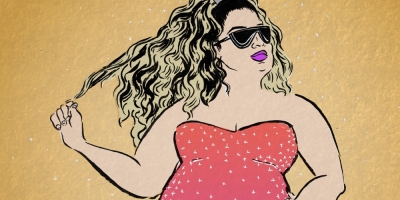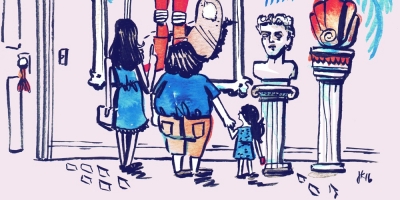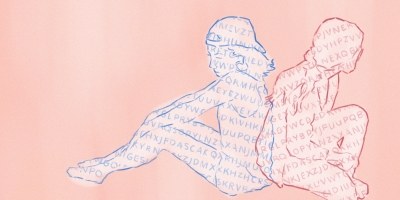Nonfiction
Tacky
by Margaret Eby

Last year, in the frenzied shopping week before Christmas, my mother offered me a gift of sorts: a former stylist friend of hers, whose fashion my mom admired, offered to tag along with us to Steinmart and help pick me out a winter coat. Never mind that picking out a winter coat in the suburbs of Jackson, Mississippi, makes about as much sense as shopping for a raincoat in Death Valley, or that I felt fairly competent at selecting my own clothes. In the spirit of the holidays and keeping the peace, I wandered the aisles of Santa ties and faux angora sweaters with my mom and her friend.
The cart filled with items of a very particular nature: shapeless, black and navy. My mom would hold up a garment, compare it to my frame, and note, “Oh, that would be flattering.” It was somewhere among the harem pants that I finally caught the eye of her friend, midway through spreading a color-blocked boat-neck number over my torso.
“I’m not actually interested in things that are flattering,” I said. “Can you take me to the tacky?”
Her face lit up, and we moved to the leopard print.
Tacky, in the upper-middle-class Alabama circles I grew up, was an omnipresent word. It’s a great one, really—it feels fun to say and particularly good to hiss, which was usually the context it was used in. Tacky could mean anything on the continuum from “rude” to “disagreeable” to “ate the last piece of cake,” encompassing a whole host of perceived social sins. (See also “ugly,” as in, “Don’t act so ugly around her.”) Forget to bring a gift to the host of a party? Tacky. Wear a spangled two-piece to prom? Tacky. Plan a wedding at the same time as a big college football game? Well, that’s just tacky.
Tackiness was, for the first twenty-plus years of my life, the quality I most tried to avoid. I’d be lying if I told you I was successful in this endeavor. Lily Pulitzer and flatirons have never really been my thing. The one time a high-school sorority attempted to recruit me, I opened the door in a chocolate-stained neon T-shirt, a dead ringer for the female lead’s “before” look in every makeover rom-com. As a teenager, most of my clothing came from an outpost on Highway 280 called J&J’s Junk that offered a garbage bag full of cast-off estate-sale garments for about ten dollars, much to the bewilderment of my mother, who was happy to bring me to the Gap. But all these experiments in tackiness were purposely mild. Clothes could be changed.
Radical transformation is a kind of gospel that American society preaches to women from a very young age. One day, you will emerge from your tangled, lumpy self as a sleek, flatironed swan. One day, the “baby fat” will just fall off you, and you’ll emerge like Aphrodite, all gold-wreathed on a clam conveyance. Your best self is always just out of reach, always receding, Tantalus-like. If you believe in the gospel, one day, everything will be just-so, enviable, the opposite of tacky. The goalposts are always moving, the race endless and exhausting. You live a life of constant failure. “Tacky,” is, of course, a signal that you are losing the race, a way of policing people—and particularly women—by letting them know that they are decidedly outside the bounds. The rules are invisible and unspoken, and you have broken one. Tackiness is a reminder of an ambient atmosphere of judgment: the unseen eyes flinching at the sight of you, the quiet, barely perceived tut-tutting.
Until fairly recently in my life, despite everything I knew to be true about the world, I believed in this system like those fervent believers who think the end of the world is imminent. My body was a stopgap, a temporary measure. I have been on the medium-fat side since high school, fluctuating a bit between exercise programs and life phases, but always a double-digit dress size. For years, though, I assumed it would only be a matter of time until suddenly I was a size four, shopping gaily for sweaters at J. Crew. (Not that size fours don’t have their own troubles, but that’s how the zap works—get smaller and all your problems are suddenly solved.)
It sounds absurd, maybe. But if you’re a fat woman, the world encourages you to treat your body like Ikea furniture. It’s disposable; it’s just there until you replace it with something nicer. You’re asked to apologize for your body, to live in a state of penitence. You don’t buy a nice dress; you shop for subsistence clothing. Other women can “get away with” willowy gowns and horizontal stripes—“get away with” as if wearing clothes were a bank robbery—but you, you’re stuck in the amorphous dark-color-block zone. You are, inherently, a little tacky.
Tacky is also a way of saying, “That is too much.” It’s a way to say, “Hush.” You’re too loud, too bright, too attention-seeking. You take up too much space. You’re too costume-y. You’re too dramatic. Your excesses are not welcome here. Its antithesis is that old chestnut “flattering,” which, in my experience, applies to any item of clothing that makes you seem smaller than you are, both in personality and in physical size. (See also “tasteful,” which assumes a hell of a lot about whose taste you are trying to please.)
It took a while for me to realize that most of the people I admire, both for their work and for their style, are tacky as hell. Even the places I love the most—houses crammed with art and books, Coney Island, New Orleans—are pretty tacky. Women who tell you what they want without apologizing are tacky. Dolly Parton, bless her wig barn, is tacky. David Bowie was a vision of tackiness. John Waters is tacky, brilliantly so.
So in my late twenties I began to embrace tacky. Not—I hope—as in “boorish,” but as in “a woman of size willing to wear pretty much whatever the hell I want.” I dyed my hair blond, for real this time, and I am not all that vigilant about covering up my brunette roots. I got a tattoo on my left arm that is large and visible. I wear cowboy boots and spangled caftans and giant earrings. (I am lucky enough to be in an office and an industry where dress code isn’t really an issue, and to live in New York City, where you usually won’t even elicit a second look unless you are in a full-on Lady Gaga meat dress.) I buy things that I think are pretty. Last year, when I had a book launch to celebrate, I had a woman make me a dress based on one of Elvis’s jumpsuits, with large rhinestone eagles on both sides. All of those things, in case it was ambiguous, are pretty much the height of tacky.
And here’s the secret: Being tacky is fun. At that suburban Steinmart pre-Christmas sale, as soon as I gave permission to the stylist to move away from the color-blocking, the trip stopped being a chore. We went to the all-sequined sheath dresses, the ridiculous ruffles, the giant fake rhinestones. I don’t think I even found a winter coat, but being far from the restraints of perceived tastefulness meant that the world stopped being quite as narrow—it was about finding things I liked, rather than clothes I anticipated other people liking.
So far, my early thirties have mostly been about setting a series of traps that prevent me from retreating from the things I know I like (pageant crowns, neon and/or metallic dresses) in favor of the ones that I feel I should like (tasteful backsplashes? blazers?). I still worry about taking up too much space. I still think about the ways that people disapprove of how I look. I still get hushed. I still hush myself. It has taken a long time—will probably take longer still—to accept that future me will look not like Karlie Kloss, but a lot like current me. But she probably will. And I bet she’ll be tacky.





